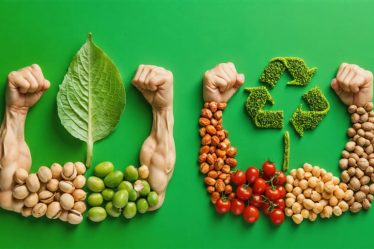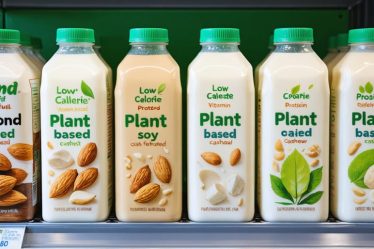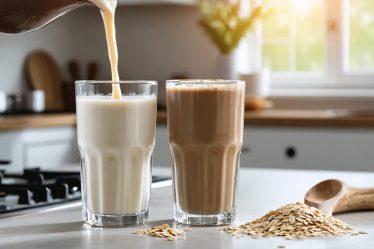
Transform your health by discovering the overlooked powerhouse of nutrition – dietary plant fiber. While transitioning to plant-based meals, I’ve learned that fiber does far more than just keep our digestive system running smoothly. This remarkable nutrient acts as nature’s internal beauty treatment, promoting glowing skin and helping maintain a healthy weight, while simultaneously reducing our risk of chronic diseases like heart disease and type 2 diabetes.
Think of dietary fiber as your body’s internal cleaning crew, sweeping through your system to maintain balance and vitality. From the satisfying crunch of fresh vegetables to the wholesome goodness of whole grains, every fiber-rich bite contributes to your body’s well-being in ways that modern processed foods simply can’t match. Whether you’re a wellness enthusiast or just starting your health journey, understanding how to harness the power of plant fiber could be the game-changing knowledge you’ve been searching for.
Join me as we explore the delicious world of fiber-rich foods and discover how this humble nutrient can revolutionize your approach to healthy eating – without sacrificing taste or satisfaction.
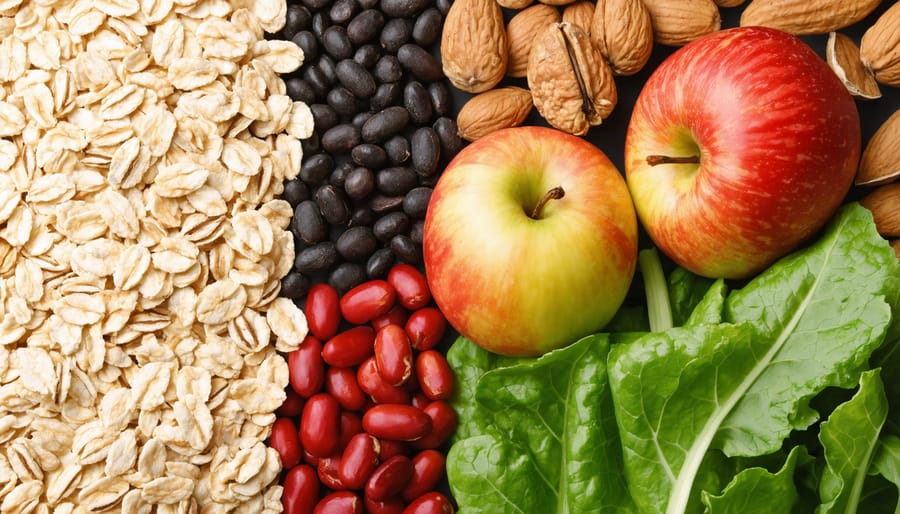
The Two Types of Plant Fiber Your Body Craves
Soluble Fiber: Your Digestive System’s Best Friend
Think of soluble fiber as your digestive system’s gentle support system – it’s like having a best friend who helps keep everything running smoothly! When this type of fiber meets water in your digestive tract, it transforms into a gel-like substance that works wonders for your body.
I discovered the magic of soluble fiber when I started incorporating more oats into my morning routine, and let me tell you, the difference was noticeable! Not only does it help maintain healthy cholesterol levels and stabilize blood sugar, but it also keeps you feeling satisfied longer – perfect for those busy days when you’re running from meeting to meeting.
You’ll find this digestive superhero in plenty of delicious foods: creamy avocados, sweet apples, tender Brussels sprouts, and hearty black beans. One of my favorite ways to boost my soluble fiber intake is adding chia seeds to my morning smoothie or oatmeal – they’re tiny but mighty when it comes to fiber content!
For those of us watching our weight, soluble fiber is especially helpful because it slows down digestion, helping us feel full and satisfied after meals. Plus, it feeds the beneficial bacteria in our gut, supporting overall digestive health and immunity.
Insoluble Fiber: Nature’s Internal Cleanse
Think of insoluble fiber as your digestive system’s personal cleaning crew. This type of fiber doesn’t dissolve in water but instead acts like a gentle scrub brush, sweeping through your digestive tract and keeping everything moving smoothly. I love to think of it as nature’s way of helping us maintain a happy, healthy gut!
You’ll find this cleansing superhero in foods you might already enjoy. Whole wheat products, brown rice, and the skins of fruits and vegetables are excellent sources. Even that satisfying crunch of nuts and seeds comes with a generous dose of insoluble fiber. As someone who struggled with digestive issues in the past, adding these foods to my daily meals has made a world of difference.
Beyond supporting regular digestion, insoluble fiber helps you feel fuller longer, which is perfect for those busy days when you need sustained energy. It’s also fantastic for maintaining a healthy weight without feeling deprived. Pro tip: Start your day with a bowl of wheat bran cereal topped with sliced almonds and berries for an insoluble fiber boost that’ll keep you energized all morning!
Beautiful Inside and Out: How Fiber Benefits Your Body
Glowing Skin and Natural Beauty
Ever noticed how your skin seems to glow after a few days of eating particularly well? That’s no coincidence! The connection between fiber-rich foods and radiant skin is one of beauty’s best-kept secrets, and I’m excited to share why loading up on plant fiber could be your ticket to that coveted natural glow.
When you consume adequate dietary fiber, it helps your body eliminate toxins more efficiently, which directly impacts your skin’s appearance. Think of fiber as your body’s internal cleansing system – it helps sweep away waste that could otherwise lead to inflammation and skin issues. Plus, fiber helps regulate blood sugar levels, which is crucial because sugar spikes can trigger breakouts and premature aging.
I discovered this connection myself when I switched to a more fiber-rich diet. Within weeks, not only did my digestion improve, but my friends started commenting on my “lit-from-within” glow. The secret lies in fiber’s ability to support your gut health, which research increasingly shows is directly linked to skin health through the gut-skin axis.
Some of the best beauty-boosting fiber sources include berries (packed with antioxidants), leafy greens (rich in skin-loving vitamins), and chia seeds (loaded with omega-3s). By incorporating these foods into your daily routine, you’re not just supporting your digestive health – you’re investing in your natural beauty routine from the inside out.

Weight Management and Energy Levels
Ever notice how some days you’re riding an energy roller coaster, while other days you feel perfectly balanced? The secret might just be in your fiber intake! As someone who used to struggle with mid-afternoon energy crashes, I’ve discovered that dietary fiber is like nature’s steady-energy advocate.
Here’s why fiber is your best friend for weight management: it acts like a natural appetite regulator. When you eat fiber-rich foods, they take longer to digest, helping you feel satisfied for hours. Think of it as your internal “portion control coach” – one that works without making you feel deprived!
But the magic doesn’t stop there. Unlike simple carbohydrates that can send your blood sugar on a wild ride, fiber helps maintain stable blood sugar levels. This means sustained energy throughout your day, without those dreaded energy dips that have you reaching for another cup of coffee.
I love starting my day with a fiber-rich breakfast bowl – it’s amazing how it keeps me energized through morning meetings and workout sessions. The best part? You don’t have to count calories obsessively. Fiber-rich foods naturally help you eat less while feeling more satisfied.
For all my busy friends out there, incorporating more plant fiber into your diet is like giving yourself the gift of sustained energy. It’s not about restrictive dieting; it’s about nourishing your body with foods that help you feel your best all day long.
Easy Ways to Add More Plant Fiber to Your Daily Meals
Breakfast Boost Ideas
Mornings can be hectic, but that doesn’t mean you have to skip on your fiber intake! I’ve discovered some delicious ways to pack more plant fiber into my breakfast routine, and I’m excited to share them with you. One of my absolute favorites is fiber-rich overnight oats – they’re a game-changer for busy mornings and can be prepped the night before.
Looking for more options? Try topping your whole grain toast with mashed avocado and chia seeds, or blend up a vibrant smoothie bowl with berries, spinach, and a sprinkle of ground flaxseeds. I’ve found that adding sliced almonds and fresh figs to my morning yogurt not only tastes amazing but also gives me that fiber boost I need to start my day right.
For those who prefer a warming breakfast, try a quinoa breakfast bowl topped with cinnamon-spiced apples and walnuts. Or whip up a batch of homemade granola loaded with oats, nuts, and dried fruits – it’s perfect for meal prep and keeps well all week.
My personal morning hack? I keep a “breakfast boost” jar filled with a mix of hemp seeds, ground flaxseeds, and wheat bran. One tablespoon of this fiber-rich blend can be added to virtually any breakfast for an instant fiber upgrade!
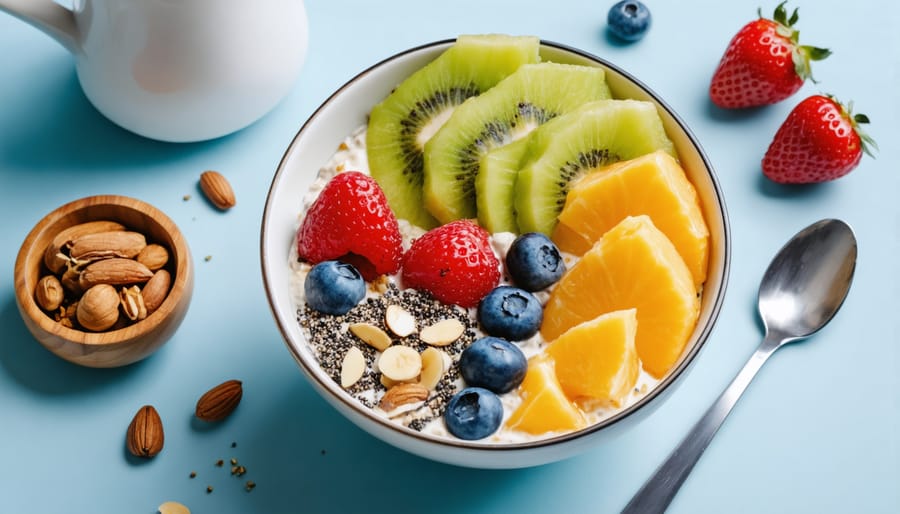
Snack Smart with Fiber
Let’s make fiber-rich snacking both delicious and effortless! As someone who used to struggle with unhealthy snacking habits, I’ve discovered that fiber-packed options can be just as satisfying as those 3 PM vending machine treats.
My go-to afternoon pick-me-up? A handful of almonds paired with fresh apple slices, delivering a perfect combination of crunch and natural sweetness, plus plenty of fiber. For those busy days when meal prep isn’t an option, try spreading hummus on whole grain crackers and topping with cucumber slices – it’s a game-changer!
Here’s a super simple recipe for my favorite fiber-rich energy balls: Mix 1 cup of rolled oats, ½ cup of almond butter, 2 tablespoons of ground flaxseed, 2 tablespoons of chia seeds, and 1 tablespoon of honey. Roll into bite-sized balls and refrigerate. They’re perfect for grab-and-go snacking!
Other fiber-packed snack ideas include:
– Roasted chickpeas with your favorite seasonings
– Mixed berry and oat smoothies
– Homemade trail mix with dried fruits and nuts
– Sliced pear with cinnamon and almond butter
– Air-popped popcorn with nutritional yeast
Remember to pair these snacks with plenty of water to help your body process the fiber effectively. Start with small portions and gradually increase your fiber intake to give your digestive system time to adjust.
Smart Tips for Transitioning to a High-Fiber Diet
Ready to boost your fiber intake but worried about potential digestive surprises? I’ve been there! When I first started increasing my fiber intake, I learned (the hard way) that slow and steady wins the race. Let me share some gentle strategies that worked for me and many others in our community.
Start by adopting a mindful approach to eating and gradually increase your fiber intake over 2-3 weeks. Think of it as training your digestive system – you wouldn’t run a marathon without proper preparation, right?
Begin by adding just 2-3 grams of fiber daily. Try swapping white bread for whole grain or adding a handful of berries to your morning yogurt. Each week, introduce new fiber-rich foods while maintaining proper hydration – aim for eight glasses of water daily to help fiber do its job effectively.
Here’s my favorite transition strategy:
Week 1: Add extra vegetables to one meal daily
Week 2: Incorporate whole grains at breakfast
Week 3: Include legumes in your lunch or dinner
Week 4: Experiment with fiber-rich snacks like apple slices with almond butter
Listen to your body during this transition. If you experience bloating or discomfort, slow down the process. Some temporary gas is normal, but severe discomfort means you might be moving too quickly.
Pro tip: Keep fiber-rich foods visible in your kitchen. I store cut vegetables at eye level in my fridge and keep a bowl of fresh fruit on my counter. This simple trick has helped me naturally increase my fiber intake without much thought.
Remember to spread your fiber intake throughout the day rather than loading up at one meal. This approach helps prevent digestive discomfort and keeps your energy levels stable. Before you know it, you’ll be enjoying all the benefits of a high-fiber diet without any uncomfortable side effects!
As we’ve explored throughout this article, dietary plant fiber is truly a powerhouse nutrient that deserves a starring role in our daily meals. From supporting digestive health and maintaining steady energy levels to promoting that coveted healthy glow we all love, the benefits of fiber are simply too good to ignore.
I remember when I first started paying attention to my fiber intake – it felt a bit overwhelming at first. But trust me, incorporating more plant fiber into your diet doesn’t have to be complicated or boring. Start small by adding an extra serving of vegetables to your lunch, swapping your morning toast for a fiber-rich grain bowl, or tossing some beans into your favorite salad.
The key is to make gradual changes that feel sustainable for your lifestyle. Whether you’re a busy mom, a career-focused professional, or somewhere in between, there’s always room to add more plant-based fiber to your plate. Your body will thank you with improved digestion, sustained energy, and that radiant complexion we talked about earlier.
Remember, every small step counts. Why not challenge yourself to try one new high-fiber food this week? Share your experiences with friends or family – you might just inspire them to join you on this journey to better health through plant fiber. Your future self will thank you for making this positive change today!

